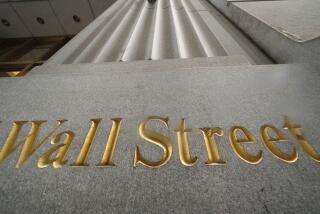Global markets sink despite promises of economic aid
- Share via
BEIJING — Global stock markets sank Wednesday in a third day of wild price swings after President Trump and other world leaders promised aid to get their economies through the coronavirus outbreak.
European markets were down about 5% after broad losses across Asia, while trading in Wall Street futures was suspended once again as losses hit the maximum 5% limit.
The White House proposal could approach $1 trillion in spending to ward off the pressure of business closures to contain the virus. The Federal Reserve has announced more measures to keep financial markets operating. Treasury Secretary Steven T. Mnuchin said Trump wants to send checks to Americans in the next two weeks to help support them while more parts of the economy come closer to shutting down.
The moves add to efforts from governments around the world that include trillions’ of dollars worth of loans for businesses, tax deferrals, mortgage relief and grants. Trump’s proposal would include $250 billion for small businesses and $50 billion for airlines.
That is a good start, but investors need to see the number of infections slow before markets can find a bottom, analysts said. The number of new cases reported in China, where the virus emerged in December, is declining but infections in the United States, Europe and elsewhere are increasing.
There are “green shoots of risk appetite emerging, and some further concerning aspects,” said Chris Weston of Pepperstone Group in a report. “I am not going to call a bottom in the risk story by any means.”
The FTSE 100 in London dropped 5.1% to 5,024 and Frankfurt’s DAX skidded 5.2% to 8,470. France’s CAC 40 shed 5.6% to 3,769.
On Tuesday, European markets swung from gains to losses and back to gains.
In Asia, the Shanghai Composite Index fell 1.8% to 2,728.76 while the Nikkei 225 in Tokyo shed 1.7% to 16,726.55. Hong Kong’s Hang Seng skidded 4.2% to 22,291.82.
The Kospi in Seoul slumped 4.9% to 1,693.95. Australia’s S&P-ASX 200 plunged to 5,320.20.
On Wall Street, the future for the benchmark S&P 500 index was down 3.7% and stopped trading, which happens automatically when it suffers a loss of at least 5%. The future for the Dow Jones Industrial Average was likewise halted, last trading down 3.9%.
On Tuesday, the S&P rose by an unusually wide daily margin of 6%, regaining just under half the previous day’s history-making loss. The Dow advanced 5.2%.
For most people, the coronavirus causes only mild or moderate symptoms, such as fever and cough, and those with mild illness recover in about two weeks. Severe illness including pneumonia can occur, especially in the elderly and people with existing health problems, and recovery could take six weeks in such cases.
On Monday, the Dow lost nearly 3,000 points after Trump said a recession may be on the way. The S&P is off 25.3% from last month’s record.
The virus has spread so quickly that its effects haven’t shown up in much U.S. economic data yet.
On Tuesday, a report showed retail sales weakened in February, when economists expected a gain. A separate report a day earlier showed manufacturing in the state of New York contracting.
“The global recession is here and now,” S&P Global economists wrote in a report Tuesday.
In energy markets, U.S. benchmark crude lost $1.59 to $25.36 per barrel in electronic trading on the New York Mercantile Exchange. It lost $1.75 to $26.95 on Tuesday.
Brent crude, the international standard, fell $1.06 to $27.67 per barrel in London.
The dollar declined to 107.47 yen from 107.67 late Tuesday. The euro retreated to $1.0984 from $1.0996.
More to Read
Inside the business of entertainment
The Wide Shot brings you news, analysis and insights on everything from streaming wars to production — and what it all means for the future.
You may occasionally receive promotional content from the Los Angeles Times.









